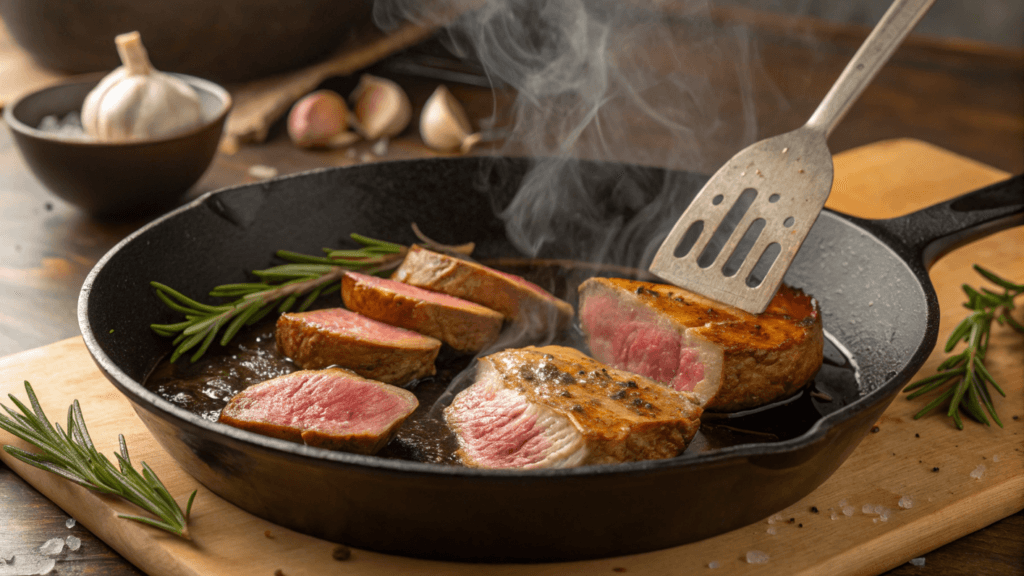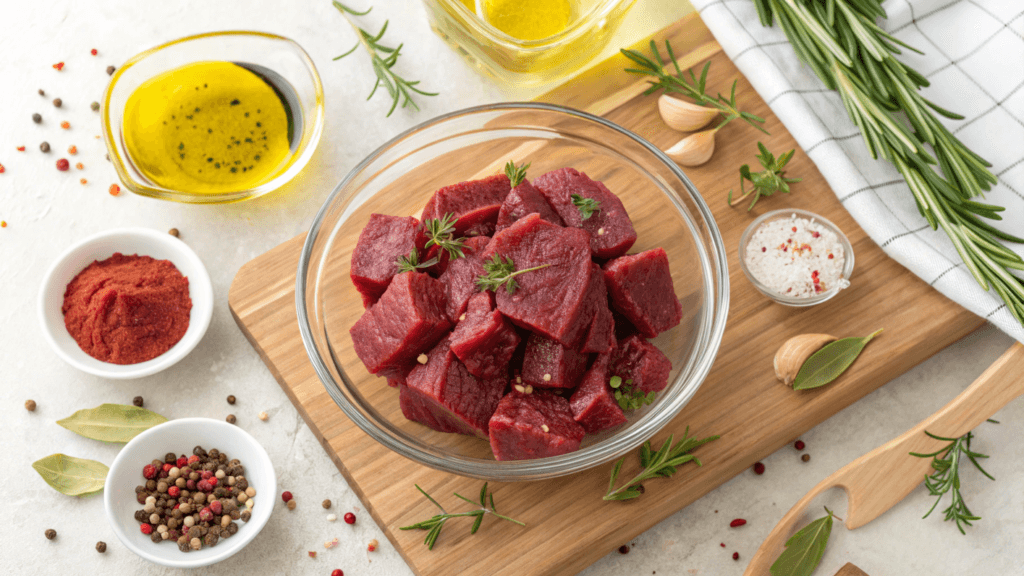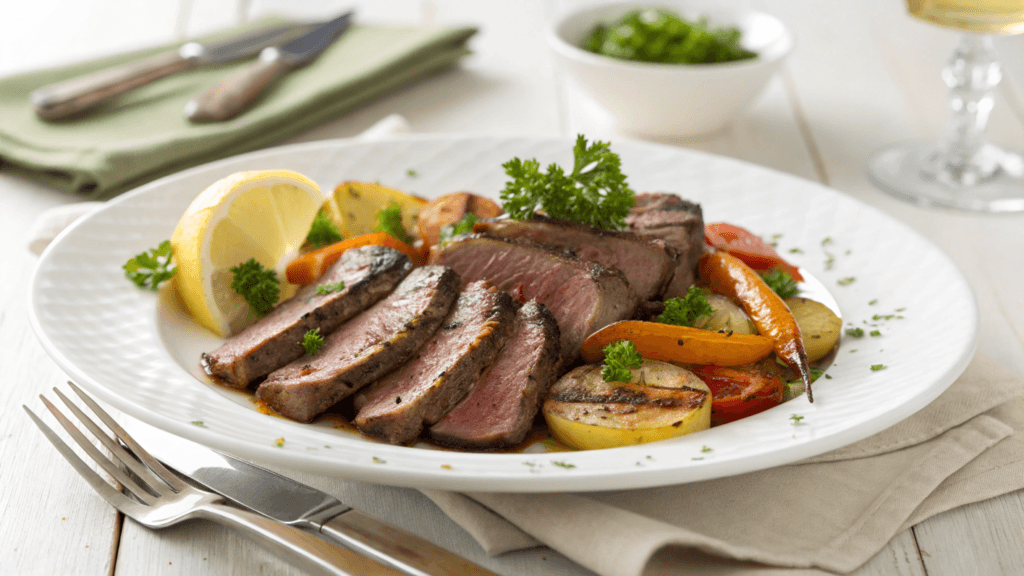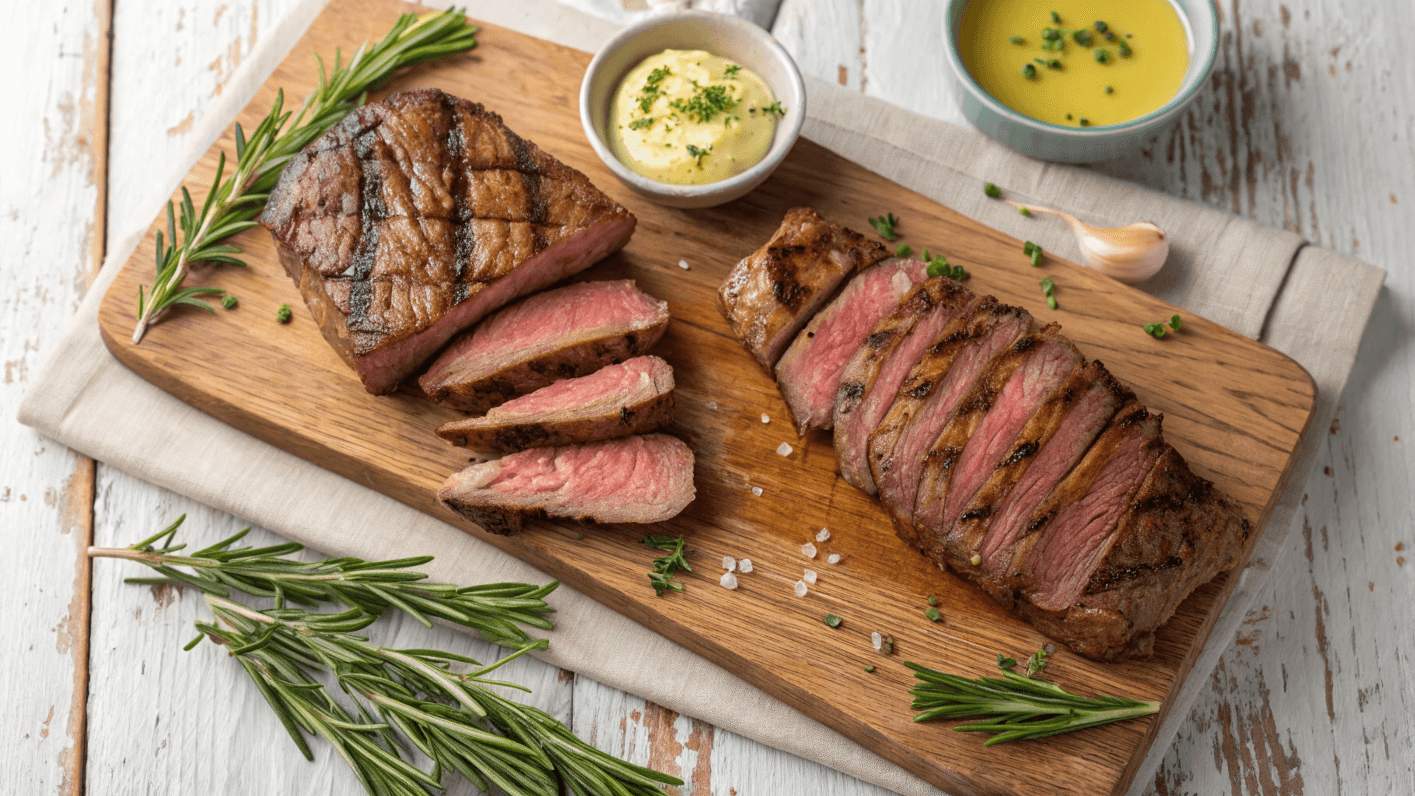When it comes to choosing the perfect cut of meat, many wonder, Is beef heart better than steak? At first, it might sound like an unusual question, but more people are exploring the benefits of lesser-known cuts. Beef heart, with its rich flavor and nutritional power, is stepping into the spotlight. It’s not just a sustainable choice—it’s also packed with protein and essential nutrients. If you’re curious about a cut that’s both budget-friendly and delicious, you’re in the right place!
Beef heart isn’t just a healthy option; it’s also incredibly versatile. You can grill it, stew it, or even slice it thin for quick meals. Its bold flavor makes it the star of any dish, while its affordability keeps your wallet happy. First, we’ll compare it to steak; then, you’ll discover how to cook it like a pro. Get ready to rethink your favorites—let’s dive in!
Table of Contents
Is Beef Heart Better Than Steak? A Comparative Analysis
Vitamins, Minerals, and Protein in Beef Heart
Beef heart is a powerhouse of nutrients. It’s packed with protein, essential vitamins like B12, and minerals like iron and zinc. First, the high protein content supports muscle health. Next, vitamins like B12 boost energy levels and brain function. In addition, beef heart is lower in fat than many steak cuts, making it a lean option.
Its high levels of CoQ10 promote heart health and overall wellness. These benefits make beef heart a fantastic choice for those seeking a nutrient-rich meal.
| Nutrient | Beef Heart (per 100g) | Steak (per 100g) |
|---|---|---|
| Protein | 17g | 25g |
| Vitamin B12 | 8.7mcg | 2.1mcg |
| Iron | 5mg | 2.7mg |
| Fat | 4g | 15g |
Understanding the unique flavor of beef heart is key to appreciating its potential in the kitchen. Its bold, slightly gamey taste may surprise you, but it’s incredibly satisfying when prepared well. For more insights into its taste, check out what beef heart tastes like. First, knowing the flavor helps you choose the right seasonings and techniques to make it shine.
How Steak Stacks Up Nutritionally
Steak is a classic protein source, offering a rich flavor and high nutritional value. It contains more protein than beef heart, which is great for building muscle. However, steak tends to have higher fat content, especially in cuts like ribeye. This can add flavor but also extra calories. In addition, steak provides a good amount of iron and zinc, essential for energy and immune health.
| Nutrient Comparison | Protein (g) | Fat (g) | Calories (kcal) |
|---|---|---|---|
| Beef Heart | 17g | 4g | 140 |
| Steak (Ribeye) | 25g | 15g | 250 |
Beef heart is often misunderstood, but it’s a true gem in the world of lean protein. While it might not be as common as steak, it’s considered beef and is packed with nutrients. If you’re curious about its classification, check out our guide on cow heart as beef. This can help you fully understand its benefits compared to traditional cuts.
The Taste and Texture Showdown
The Bold Flavor and Chewy Texture of Beef Heart
Beef heart has a distinct, bold flavor that sets it apart. Its slightly chewy texture becomes tender when cooked properly. First, marinating helps enhance the taste and soften the muscle fibers. Then, slow cooking or grilling locks in the rich, beefy flavor. Unlike steak, it has a denser texture, making it feel more filling. With the right preparation, it can easily rival the tenderness of traditional cuts.
Steak’s Tenderness and Classic Appeal
Steak is known for its melt-in-your-mouth texture and juicy flavor. Cuts like filet mignon are naturally tender and easy to cook. In addition, the marbling in steak adds richness that beef heart lacks. However, it requires careful cooking to avoid toughness. Steak’s versatility and classic appeal make it a favorite at any dinner table.
- Best cuts for tenderness: Filet mignon, ribeye, and sirloin.
- Cooking methods: Grilling, searing, or slow-roasting.
- Add flavors with simple seasonings like salt, pepper, and garlic.
Cooking Tips for Beef Heart and Steak
Marinating and Preparing Beef Heart for Best Results
Marinating is essential for making beef heart tender and flavorful. Start with a base of olive oil, garlic, and lemon juice. First, the acidity in the lemon juice breaks down tough fibers. Then, spices like paprika or cumin add depth to the flavor. Let it marinate for at least 6 hours. Slice it thinly against the grain for easier chewing.
| Step | Action | Benefit |
|---|---|---|
| 1 | Rinse and clean beef heart | Removes impurities |
| 2 | Slice thinly against the grain | Reduces chewiness |
| 3 | Marinate for 6-8 hours | Enhances tenderness and flavor |
Cooking beef heart may sound intimidating, but it’s simpler than you think. The right techniques can turn it into a tender, flavorful dish. From marinating to grilling, there are several ways to get the best results. For detailed steps, check out our guide on the best ways to prepare beef heart. Each method ensures you make the most of this versatile cut.

Foolproof Methods to Cook the Perfect Steak
Cooking steak to perfection requires attention to detail. First, bring the steak to room temperature before cooking. Then, season generously with salt and pepper. Use high heat to sear each side for a caramelized crust. For even cooking, finish in the oven or reduce heat. Resting the steak is crucial to lock in the juices.
- Tips for perfect steak:
- Use a meat thermometer for accurate doneness.
- Rest for 5-10 minutes after cooking.
- Try reverse-searing for thicker cuts.
Affordability and Accessibility Compared
Why Beef Heart Is the Budget-Friendly Choice
Beef heart is an incredibly affordable option, especially when compared to premium steak cuts. It’s often overlooked, which keeps its price low. This makes it an excellent choice for families, budget-conscious shoppers, or anyone looking to get the most value for their money. In addition to being cost-effective, beef heart is nutrient-dense. It offers high amounts of protein, iron, and essential vitamins at a fraction of the cost of steak.
You’ll typically find beef heart in specialty stores or butcher shops. While it’s less common in supermarkets, it’s worth seeking out. Many local farmers and markets offer it at great prices. The affordability doesn’t compromise its quality, making it accessible to everyone. Plus, a single beef heart can serve multiple people, adding to its value.
Steak: A High-Value But Pricey Option
Steak, on the other hand, is often considered a luxury item due to its price. Premium cuts like ribeye or filet mignon can be costly, especially if sourced from grass-fed or organic beef. This higher price tag reflects not only the quality of the meat but also the labor-intensive processes involved in raising cattle for these cuts.
However, steak’s accessibility is unmatched. You’ll find a wide variety of steak cuts in almost every supermarket, butcher shop, or restaurant. Its popularity makes it an easy choice for special occasions or indulgent meals. Despite the price, many consider steak worth the splurge for its tender texture and classic flavor.
| Comparison of Affordability and Accessibility | Beef Heart | Steak |
|---|---|---|
| Price (per pound) | $3-$5 | $10-$20+ |
| Availability | Specialty stores, farmers’ markets | Widely available in stores |
| Servings per unit | 4-6 | 1-3 |
| Popularity | Less common | Extremely popular |
By balancing cost and availability, beef heart emerges as the budget-friendly choice for adventurous cooks, while steak continues to hold its place as a staple for indulgence. The choice ultimately depends on your preferences, but exploring beef heart could save you money without sacrificing flavor or nutrition. Try both to discover which works best for your lifestyle!
Sustainability and Ethics in Choosing Your Meat
Beef Heart: A Sustainable Protein Alternative
Beef heart is a sustainable choice because it utilizes the whole animal. This reduces waste and supports ethical consumption. It also has a smaller environmental footprint compared to traditional steak cuts. By choosing beef heart, you contribute to reducing food waste while enjoying a healthy meal.
Environmental Concerns of Traditional Steak Production
Steak production has a significant environmental impact. Raising cattle for premium cuts requires more resources, such as land and water. Additionally, higher demand for steak increases carbon emissions. Choosing alternatives like beef heart can help reduce these effects.
- Environmental challenges of steak production:
- High water usage for cattle farming.
- Larger carbon footprint per kilogram of meat.
- Overgrazing leading to land degradation.
Now that you know why beef heart deserves a spot on your plate, let’s turn this nutritional powerhouse into a mouthwatering masterpiece—get ready to cook something amazing!
Ingredients
Let’s gather everything you need for this recipe! Each ingredient has its own role to make this dish shine:

- Beef Heart (500g, cleaned and trimmed) – The star of the show! Beef heart is rich, flavorful, and packed with nutrients. First, its lean yet bold texture adds a unique depth to the dish. In addition, it’s affordable and sustainable, making it a great alternative to steak.
- Lemon Juice (2 tablespoons) – This zesty ingredient works wonders in tenderizing the beef heart. The acidity breaks down the muscle fibers, making every bite tender and juicy. Plus, it adds a fresh, tangy flavor.
- Olive Oil (2 tablespoons) – Olive oil locks in moisture and helps create a silky marinade. It also adds a subtle richness that balances the bold flavors of the heart meat.
- Garlic (3 cloves, minced) – Garlic adds a warm, savory depth to the dish. It infuses the marinade with a comforting aroma and pairs perfectly with beef heart.
- Fresh Herbs (2 tablespoons, chopped) – A mix of parsley, thyme, and rosemary adds an earthy, aromatic touch. These herbs elevate the flavor while making the dish vibrant and fresh.
- Paprika (1 teaspoon) – Paprika gives a smoky, slightly sweet kick that complements the richness of the beef heart.
Step-by-Step Instructions
Follow these steps to make your Tender Herb-Marinated Beef Heart a flavorful success:
- Prepare the Beef Heart – First, clean the beef heart by removing any fat or connective tissue. Then, slice it thinly against the grain to reduce chewiness.
- Create the Marinade – In a bowl, mix lemon juice, olive oil, garlic, herbs, and paprika. Next, season with salt and pepper to taste. Stir well to combine all the flavors.
- Marinate the Beef Heart – Place the sliced beef heart into the bowl. Ensure every piece is coated with the marinade. Cover and refrigerate for at least 6 hours, or overnight for deeper flavor.
- Cook the Beef Heart – Heat a skillet over medium-high heat. Once hot, add a drizzle of olive oil. Sear the slices for 2-3 minutes on each side until golden brown. Avoid overcooking, as it can make the meat tough.
- Rest and Serve – Remove the beef heart from the skillet and let it rest for 5 minutes. This allows the juices to redistribute, ensuring tender, flavorful bites.
Serving
This recipe serves 4 people and is perfect for any occasion.
- How to Serve: Arrange the slices on a plate and drizzle with any leftover juices from the skillet. Serve it alongside roasted vegetables or a grain like quinoa for a hearty meal.
- Optional Garnishes: Add a sprinkle of fresh parsley or a wedge of lemon for extra freshness.
- For a Fun Twist: Stuff the slices into pita bread with hummus and crunchy greens for a unique sandwich option!

Enhancing your beef heart recipe with the right seasoning is a game-changer. Garlic butter seasoning, for instance, brings out the rich flavors of the meat while adding a creamy, savory touch. For a simple and delicious recipe, try our garlic butter seasoning. It’s a versatile option that pairs beautifully with any beef heart dish.
Tips and Hacks
Here’s how to make this recipe even better:
- Tenderize More: If time allows, marinate overnight for maximum tenderness and flavor.
- Spice It Up: Add a pinch of chili flakes for a subtle heat that complements the smoky paprika.
- Versatile Marinade: Use this marinade for other lean meats, like chicken breast or turkey.
- Storage Tips: Store leftovers in an airtight container in the fridge for up to 3 days. Reheat gently to maintain texture.
Nutrition Facts
- Serving size: 125g
- Calories: 230
- Fat: 8g
- Carbs: 3g
- Protein: 32g
- Sodium: 150mg
- Fiber: 1g
Please note: Nutrition values are estimates and may vary based on ingredient brands and preparation methods.
Prep Time
- Prep time: 15 minutes
- Cook time: 10 minutes
- Total time: 25 minutes
Please note: Marination time is not included in total time, as it can vary based on preference.
This recipe is the perfect way to explore whether beef heart is truly better than steak. Give it a try and let the flavors speak for themselves!
Frequently Asked Questions:
How often should you eat beef heart?
You can enjoy beef heart once or twice a week as part of a balanced diet. First, it’s rich in nutrients like protein, iron, and B vitamins. Also, it’s a lean option compared to other cuts of beef. In addition, its high CoQ10 content supports heart health. Rotate it with other proteins for variety and enjoy its unique flavor guilt-free!
What is the healthiest beef organ to eat?
Beef liver is often considered the healthiest organ to eat, thanks to its incredible nutrient density. It’s packed with vitamins A and B12, along with iron and folate. However, beef heart is a close second! It’s leaner, high in protein, and rich in CoQ10. Both are excellent choices, so pick the one that fits your taste and dietary needs. Variety makes it fun!
Is beef liver healthier than steak?
Yes, beef liver is healthier than steak in terms of nutrient density. It contains more vitamins, particularly A, B12, and folate. Liver is also lower in fat while offering a significant iron boost. On the other hand, steak provides more protein and is a versatile option for meals. Including both in your diet ensures you get the best of both worlds!
Conclusion: Discover the Best Choice for You
So, is beef heart better than steak? It all comes down to your goals and preferences. Beef heart is a nutrient-packed, affordable option that offers bold flavors and sustainability. On the other hand, steak is a classic choice with tender textures and versatile cooking options.
First, think about your priorities—are you looking for a lean, healthy protein or an indulgent, rich cut? Next, consider variety. Including both in your meals adds excitement to your menu. Also, don’t shy away from experimenting! Beef heart can surprise you with its taste and versatility.
Finally, whether you’re grilling steak for a special occasion or marinating beef heart for a weeknight meal, both cuts deserve a place in your kitchen. You’re going to love exploring the best of both worlds, so grab your favorite and get cooking today!
Now that you’ve learned the benefits and preparation tips, why not explore more beef heart dishes? From stews to skewers, there’s a world of possibilities waiting for you. For inspiration, visit our collection of beef heart recipes. Each recipe showcases the versatility and deliciousness of this underrated cut. Give it a try and discover your new favorite dish!


1 thought on “Is Beef Heart Better Than Steak? Compare Nutrition, Flavor, and Cost to Choose the Best Cut!”